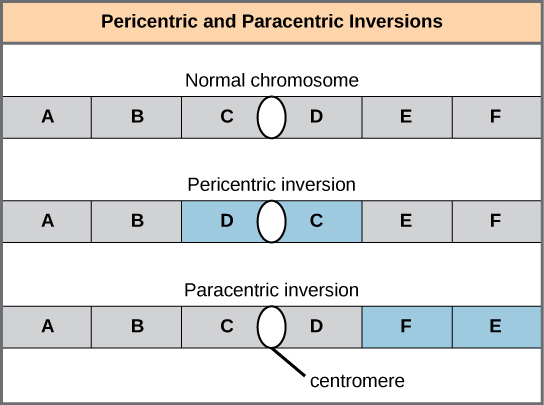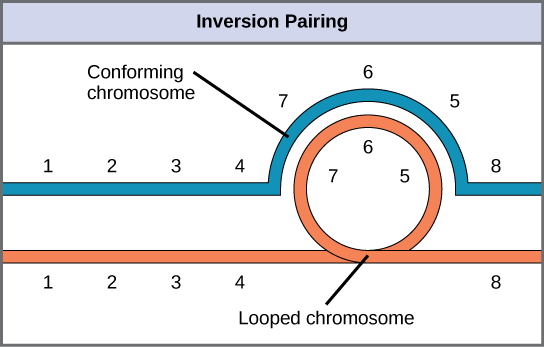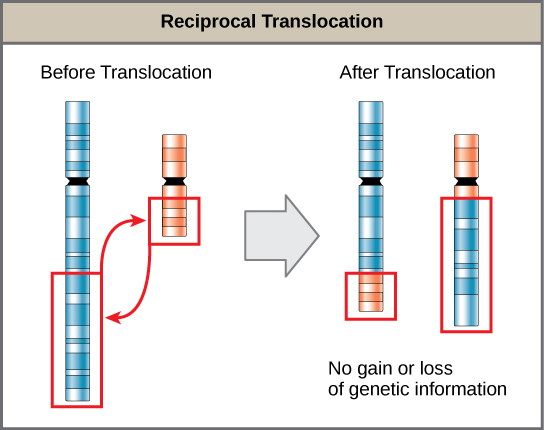Chromosomal Structural Rearrangements
Cytologists have characterized numerous structural rearrangements in chromosomes, but chromosome inversions and translocations are the most common. We can identify both during meiosis by the adaptive pairing of rearranged chromosomes with their former homologs to maintain appropriate gene alignment. If the genes on two homologs are not oriented correctly, a recombination event could result in losing genes from one chromosome and gaining genes on the other. This would produce aneuploid gametes.
Chromosome Inversions
A chromosome inversion is the detachment, 180° rotation, and reinsertion of part of a chromosome. Inversions may occur in nature as a result of mechanical shear, or from transposable elements' action (special DNA sequences capable of facilitating rearranging chromosome segments with the help of enzymes that cut and paste DNA sequences). Unless they disrupt a gene sequence, inversions only change gene orientation and are likely to have more mild effects than aneuploid errors. However, altered gene orientation can result in functional changes because regulators of gene expression could move out of position with respect to their targets, causing aberrant levels of gene products.
An inversion can be pericentric and include the centromere, or paracentric and occur outside the centromere (Figure). A pericentric inversion that is asymmetric about the centromere can change the chromosome arms' relative lengths, making these inversions easily identifiable.

When one homologous chromosome undergoes an inversion but the other does not, the individual is an inversion heterozygote. To maintain point-for-point synapsis during meiosis, one homolog must form a loop, and the other homolog must mold around it. Although this topology can ensure that the genes correctly align, it also forces the homologs to stretch and can occur with imprecise synapsis regions (Figure).

Evolution Connection
The Chromosome 18 InversionNot all chromosomes' structural rearrangements produce nonviable, impaired, or infertile individuals. In rare instances, such a change can result in new species evolving. In fact, a pericentric inversion in chromosome 18 appears to have contributed to human evolution. This inversion is not present in our closest genetic relatives, the chimpanzees. Humans and chimpanzees differ cytogenetically by pericentric inversions on several chromosomes and by the fusion of two separate chromosomes in chimpanzees that correspond to chromosome two in humans.
Scientists believe the pericentric chromosome 18 inversion occurred in early humans following their divergence from a common ancestor with chimpanzees approximately five million years ago. Researchers characterizing this inversion have suggested that approximately 19,000 nucleotide bases were duplicated on 18p, and the duplicated region inverted and reinserted on chromosome 18 of an ancestral human.
A comparison of human and chimpanzee genes in the region of this inversion indicates that two genes—ROCK1 and USP14—that are adjacent on chimpanzee chromosome 17 (which corresponds to human chromosome 18) are more distantly positioned on human chromosome 18. This suggests that one of the inversion breakpoints occurred between these two genes. Interestingly, humans and chimpanzees express USP14 at distinct levels in specific cell types, including cortical cells and fibroblasts. Perhaps the chromosome 18 inversion in an ancestral human repositioned specific genes and reset their expression levels in a useful way. Because both ROCK1 and USP14 encode cellular enzymes, a change in their expression could alter cellular function. We do not know how this inversion contributed to hominid evolution, but it appears to be a significant factor in the divergence of humans from other primates.Violaine Goidts et al., “Segmental duplication associated with the human-specific inversion of chromosome 18: a further example of the impact of segmental duplications on karyotype and genome evolution in primates,” Human Genetics. 115 (2004):116-122
Translocations
A translocation occurs when a chromosome segment dissociates and reattaches to a different, nonhomologous chromosome. Translocations can be benign or have devastating effects depending on how the positions of genes are altered with respect to regulatory sequences. Notably, specific translocations have occurred with several cancers and with schizophrenia. Reciprocal translocations result from exchanging chromosome segments between two nonhomologous chromosomes such that there is no genetic information gain or loss (Figure).
